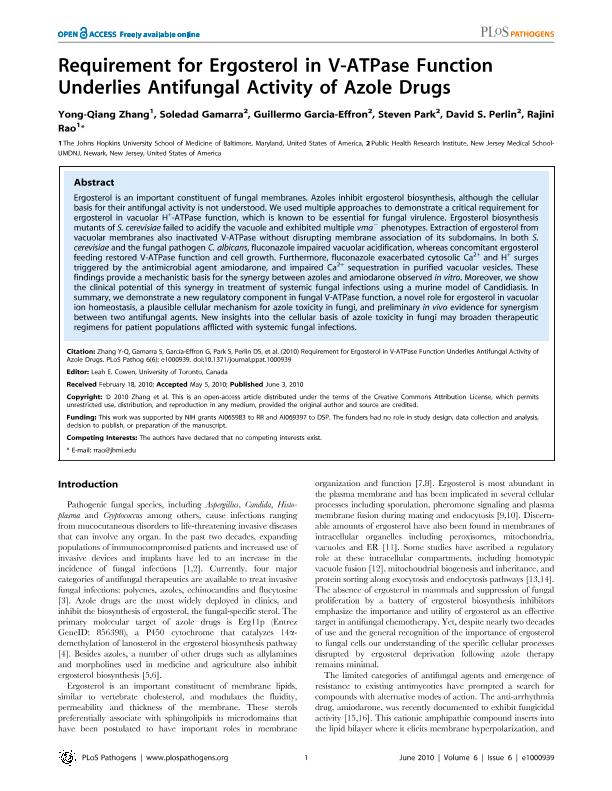Mostrar el registro sencillo del ítem
dc.contributor.author
Zhang, Yong-Qiang
dc.contributor.author
Gamarra, Maria Soledad

dc.contributor.author
Garcia, Guillermo Manuel

dc.contributor.author
Park, Steven
dc.contributor.author
Perlin, David S.
dc.contributor.author
Rao, Rajini
dc.date.available
2020-02-23T22:47:05Z
dc.date.issued
2010-06
dc.identifier.citation
Zhang, Yong-Qiang; Gamarra, Maria Soledad; Garcia, Guillermo Manuel; Park, Steven; Perlin, David S.; et al.; Requirement for Ergosterol in V-ATPase Function Underlies Antifungal Activity of Azole Drugs; Public Library of Science; Plos Pathogens; 6; 6-2010; 1-13
dc.identifier.issn
1553-7366
dc.identifier.uri
http://hdl.handle.net/11336/98389
dc.description.abstract
Ergosterol is an important constituent of fungal membranes. Azoles inhibit ergosterol biosynthesis, although the cellular basis for their antifungal activity is not understood. We used multiple approaches to demonstrate a critical requirement for ergosterol in vacuolar H+-ATPase function, which is known to be essential for fungal virulence. Ergosterol biosynthesis mutants of S. cerevisiae failed to acidify the vacuole and exhibited multiple vma~ phenotypes. Extraction of ergosterol from vacuolar membranes also inactivated V-ATPase without disrupting membrane association of its subdomains. In both S. cerevisiae and the fungal pathogen C. albicans, fluconazole impaired vacuolar acidification, whereas concomitant ergosterol feeding restored V-ATPase function and cell growth. Furthermore, fluconazole exacerbated cytosolic Ca2+ and H+ surges triggered by the antimicrobial agent amiodarone, and impaired Ca2+ sequestration in purified vacuolar vesicles. These findings provide a mechanistic basis for the synergy between azoles and amiodarone observed in vitro. Moreover, we show the clinical potential of this synergy in treatment of systemic fungal infections using a murine model of Candidiasis. In summary, we demonstrate a new regulatory component in fungal V-ATPase function, a novel role for ergosterol in vacuolar ion homeostasis, a plausible cellular mechanism for azole toxicity in fungi, and preliminary in vivo evidence for synergism between two antifungal agents. New insights into the cellular basis of azole toxicity in fungi may broaden therapeutic regimens for patient populations afflicted with systemic fungal infections.
dc.format
application/pdf
dc.language.iso
eng
dc.publisher
Public Library of Science

dc.rights
info:eu-repo/semantics/openAccess
dc.rights.uri
https://creativecommons.org/licenses/by-nc-sa/2.5/ar/
dc.subject
ERGOSTEROL
dc.subject
V-ATPASE
dc.subject
AZOLE
dc.subject
AMIODARONE
dc.subject.classification
Bioquímica y Biología Molecular

dc.subject.classification
Medicina Básica

dc.subject.classification
CIENCIAS MÉDICAS Y DE LA SALUD

dc.title
Requirement for Ergosterol in V-ATPase Function Underlies Antifungal Activity of Azole Drugs
dc.type
info:eu-repo/semantics/article
dc.type
info:ar-repo/semantics/artículo
dc.type
info:eu-repo/semantics/publishedVersion
dc.date.updated
2020-02-13T18:58:18Z
dc.journal.volume
6
dc.journal.pagination
1-13
dc.journal.pais
Estados Unidos

dc.journal.ciudad
San Francisco
dc.description.fil
Fil: Zhang, Yong-Qiang. Johns Hopkins School Of Medicine;
dc.description.fil
Fil: Gamarra, Maria Soledad. Public Health Research Institute;
dc.description.fil
Fil: Garcia, Guillermo Manuel. Universidad Nacional del Litoral; Argentina
dc.description.fil
Fil: Park, Steven. Public Health Research Institute;
dc.description.fil
Fil: Perlin, David S.. Public Health Research Institute;
dc.description.fil
Fil: Rao, Rajini. Johns Hopkins School Of Medicine;
dc.journal.title
Plos Pathogens

dc.relation.alternativeid
info:eu-repo/semantics/altIdentifier/doi/http://dx.doi.org/10.1371/journal.ppat.1000939
Archivos asociados
